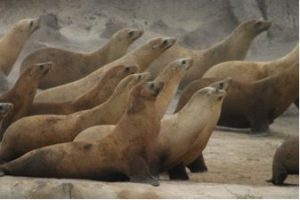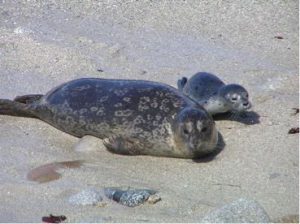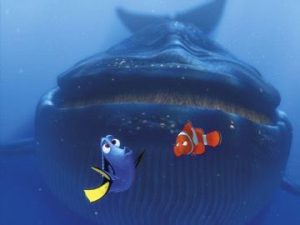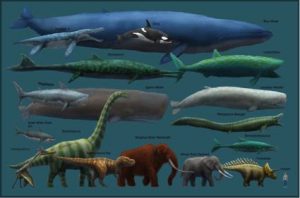It’s so exciting to see marine mammals at CIMI! With spring migrations in full swing, we are feeling very lucky to be seeing lots of grey whales, common dolphins, and Risso’s dolphins among many more in San Pedro channel.

Scientists still don’t know why Risso’s dolphins scar each other’s skin with their teeth in unique patterns like this. (Image credit: Cosmos Magazine)
What is a marine mammal?
Mammals have five characteristics that separate them from other animals: they breathe oxygen, have hair or fur, give birth to live young that females nurse with milk from mammary glands (called lactation), and are warm-blooded. Marine mammals are mammals that rely on the ocean for their primary food source.
What are some types of marine mammals?
There are five groups of marine mammals:
- Whales and dolphins (cetacea)
- Seals and sea lions (pinnipedia)
- Sea otters (they’re members of the weasel family!)
- Manatees and dugongs (sirenia)
- and, yes, even polar bears!
Where did marine mammals come from?
Isn’t it strange that mammals who need to breathe oxygen and keep warm live in underwater habitats? Scientists believe that marine mammals such as whales evolved from dog-like creatures that ate fish, and slowly developed characteristics that helped them spend longer in the water to hunt.
Why are marine mammals important?
Because they are big, beautiful, and some seem ‘cuddly’, and because so many species are threatened by poaching, habitat destruction, and pollution, marine mammals are often the “poster child” for ocean conservation. But they are more than just a mascot; marine mammals are apex predators in their habitats, meaning they are very important to keep other populations in check. For example, sea otters love to feed on urchins, and urchins are powerful ocean grazers. If a sea otter population is threatened, urchins often take over because their population grows so quickly in the absence of predators. This can create “urchin barrens,” or areas where habitat for small invertebrates and fish is completely destroyed because all the algae and kelp has been eaten by urchins!
Fun marine mammal facts:
- You can tell a sea lion apart from a seal by looking at its front flippers, ears, swimming, and social behavior: sea lions have longer, more developed flippers that allow for easier motion on land. They also have small ear flaps, “porpoise” or play and flip at the surface of the water, raise young in large groups, and adopt orphan pups. Seals, on the other hand, have shorter flippers and are awkward on land. They have small ear holes instead of ear flaps, “periscope” or pop up for a quick look and breath before diving down for long periods of time, and are more solitary in their behavior.

California Sea Lions

Harbor seals (Image credits: NOAA/Dan Linehan)
- Orcas and dolphins are “odontocetes,” which means “toothed whale.” They are carnivorous and eat mostly fish and small invertebrates. Most larger whales are “mysticetes,” which means “mustached whale” — named for the fibrous baleen that helps these massive creatures feed on tiny plankton and krill that they filter into their mouths.

No wonder this guy didn’t want to eat Nemo and Dory after all! (Image Credit: Disney)
- A blue whale is the largest animal that is living — or has ever lived — on Earth, measuring in at 30 meters!

Blue whales are about three “Megalodons” long. Ssssh… don’t tell T-rex. (Image credit: Pukatea.blogspot.com)
We could talk all day about marine mammals at CIMI, but here are some other places to explore for more:
To learn more about marine mammals and see a longer list of species, check out the National Oceanic and Atmospheric Administration’s page about them here: http://www.nmfs.noaa.gov/pr/species/mammals/
To learn more about exciting new research about Risso’s dolphins, check out this article in Cosmos Magazine: https://cosmosmagazine.com/life-sciences/social-network-rissos-dolphins/
To learn more about marine mammal conservation and rehabilitation, check out the marine mammal center’s website at http://www.marinemammalcenter.org/


